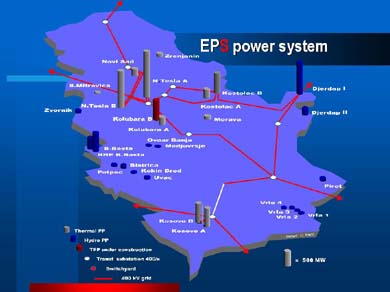|
Energy and Mining

The electric power system of Serbia (click on photo to enlarge)
|
The Electric Utility Company of Serbia (EPS) encompasses coal mines, electric power sources (hydroelectric power plants, thermal power plants, heating plants) and grid distribution systems.
Serbia is not rich in power resources. At the current level of production which meets only 25% of the country’s needs, Serbia (excluding Kosovo) will have a supply of coal for the next 55 years and oil and gas for 20 years. The current hydroelectric power capacity is 10,200 GWh per year, while potential capacity is estimated at 14,200 GWh per year.
Electricity consumption in households has been increasing for the last two years, while electric consumption in industry has been steadily decreasing. Electricity consumption per capita increased by 44% between 1990 and 2000.
Over the last ten years, capacity of power plants has decreased by 77% due to poor maintenance. Output capacity was reduced since Kosovo is not covered by EPS. No new power plant has been built over the last decade, and only one major repair overhaul has been performed. Losses in transmission and distribution have been on the increase since 1990 and are at the highest level in Europe. Electricity prices are several times lower relative to other countries in the region.
From 1975 to 1990, US$450 million was invested in EPS on a yearly basis (a total of US$7.5 billion). In the period between 1990 and 2000, less than 10% of planned funds were invested in repairs and maintenance works per year.
There is an urgent need for construction of new power plants.
For six successive winters, Serbia has had an electricity deficit – up to 40% on an average winter day. In the year 2000, 55 days of power failures were registered in Serbia. Average daily import of electricity in the winter of 2000 was larger than the maximum possible output of the country’s largest power plant, TENT B, or hydroelectric power plants Djerdap I and Djerdap II combined.
In order to boost coal production, we need to find an exploitation field, raise the level of system operation reliability, increase system capacity and improve working conditions.
There are 42 city heating plants in Serbia with heat energy capacity of 5,500 MW. However, Serbia does not have sufficient energy production or funds for their procurement. The main characteristics of Serbia’s heating plants are low operating readiness due to insufficient maintenance and outdated equipment, financial exhaustion and an inability to perform urgent intervention on sources and grids. Heating is poor and there is a need for additional capacity.
MINING INDUSTRY
The Mining industry in Serbia represents the foundation of domestic industry, and therefore of the Serbian economy in general.
Coal
Low-calorie coals - lignites, which are mined at the Kolubara and Kostolac sites, provide 65% of the electric power in Serbia. Significantly, available data shows that one Kolubara excavation site alone- Field D, provides 32% of the electric power in Serbia.
Building material
Despite the general trend of industrial production in Serbia, building material production is a significant and profitable segment of industry which has been in a continuous process of development (20% growth in the year of 2000), and is based primarily on mineral materials, i.e. on mining.
The main producers of building material are the cement factories in Beocin, Kosjeric and Novi Popovac, brick factories in Kikinda, Novi Becej, Novi Pazar, Ruma, and Kanjiza. Excavation of technical and building stone is also a profitable mining sector, with sites near Ub, in Topola, Jelen Do, and Aranjelovac. Private sector initiative is most prominent in this sector - exploitation of nonmetals and building material.
Copper and precious metals
The Bor Mining and metallurgical complex produces copper ore in quantities that are significant on a regional level. Secondary precious metal refining is also substantial.
Exploitation of industrial minerals in Serbia will soon be of great consequence. Highly profitable projects are planned partly based on estimated and partly on confirmed reserves of boron minerals, phosphates, zeolites, granite alluviums, ilmenite, zircon, etc. Foreign companies are especially interested in exploitation of industrial materials.
Underground water
According to the Ministry of Energy and Mining, nine out of ten requests for mineral material research are issued for research on underground water, which clearly points to their significance. The main commercial mineral water producers are successful companies such as Knjaz Milos, Rosa, Leda, Bivoda, Palanacki kiseljak etc.
|